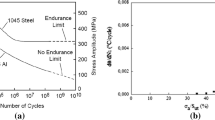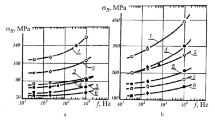Abstract
A brief historical review of the development of research of fatigue resistance of metallic materials is presented. Published data and our own results are used to analyze fatigue curves at various endurances and mechanisms of crack nucleation in fatigue tests.
Similar content being viewed by others
References
D. Dengel, “Planung und Auswertung von Dauerschwingversuchen bei angestrebter statistischer Absicherung der Kennwerte,” in: Verhalten von Stahl bei schwingender Beanspruchug, Stahleisen M. B. H., Düsseldorf (1978), pp. 23–46.
V. F. Tetent’ev, Fatigue Resistance of Metals and Alloys [in Russian], Intermet Engineering, Moscow (2002).
S. Suresh, Fatigue of Materials, Cambridge University Press, Cambridge (2003).
C. Bathias, Gigacycle Fatigue in Mechanical Practice, Marcel Dekker Verlag (2005).
F. Brainthwaite, “On the fatigue and consequent fracture of metals,” Institution of Civil Engineers, Minutes of Proceedings (1854), pp. 463–474.
C. Hood, in: Institution of Civil Engineers, Minutes of Proceedings, Vol. 2 (1842), p. 180.
H. F. Moore and J. B. Kommers, The Fatigue of Metals, New York (1927).
A. Z. Wöhler, Zeitschrift für Bauwesen, 8, 642 (1858); ibid., 10, 583 (1860); ibid., 13, 233 (1863); ibid., 16, 67 (1866); ibid., 20, 74 (1870).
H. J. Gough, The Fatigue of Metals, London (1926).
M. E. Fine, “Fatigue resistance of metals,” Metall. Trans. A, 11A, March, 365–379 (1980).
V. F. Terent’ev, “To the problem of fatigue limit of metallic materials,” Metalloved. Term. Obrab. Met., No. 6, 22–28 (2004).
V. F. Terent’ev, Fatigue of Metallic Materials [in Russian], Nauka, Moscow (2003).
N. A. Makhutov, “Fatigue of metals in a wide range of the number of cycles,” Zavod. Lab. Diagn. Mater., 70(4), 37–41 (2004).
I. Marines, X. Bin, and C. Bathias, “An understanding of very high cycle fatigue of metals,” Int. J. Fatigue, 25, 1101–1107 (2003).
H. F. Moore and J. B. Kommers, “An investigation of the fatigue of metals,” Bull. Eng. Expt. Stat., Univ. Illinois (U.S.A.), No. 124.
V. F. Terent’ev, “Fatigue of high-strength steels. Part 1. Correlation with ultimate strength, form of fatigue curves, and crack nucleation,” Deform. Razrush. Mater., No. 8, 2–11 (2006).
H. Mughrabi, “On ‘multi-stage’ fatigue life diagrams and the relevant life-controlling mechanisms,” in: Proc. Int. Conf. on “Fatigue in the Very High Cycle Regime”, 2–4 July, 2001, Vienna, Austria, Inst. Meteorol. and Phys. Austria (2001), pp. 35–49.
J. M. Zhang, S. X. Li, Z. O. Yang, et al., “Influence of inclusion size on fatigue behavior of high strength steels in the gigacycle fatigue regime,” Int. J. Fatigue, 29, 765–771 (2007).
Q. Chen, N. Kawagoishi, Q. Y. Wang, et al., “Small crack behavior and fracture of nickel-based superalloy under ultrasonic fatigue,” Int. J. Fatigue, 27, 10–12, 1227–1232 (2005).
A. Zh. Afonin, E. A. Kuzmenko, and A. D. Shevchuk, “On the problem of the effect of loading frequency on fatigue strength of metals,” Probl. Prochn., No. 4, 62–67 (1972).
V. F. Terent’ev, “A model of physical fatigue limit of metals and alloys,” Dokl. Akad. Nauk SSSR, 185(2), 324–326 (1969).
V. F. Terent’ev, “Processes of micro-and macroscopic deformation of metallic materials below the fatigue limit,” Metally, No. 5, 73–80 (2003).
L. A. Glikman and V. P. Tekht, “On the problem of the physical nature of the process of fatigue of metal” in: Some Problems of Fatigue Strength of Steel [in Russian], Mashgiz, Moscow-Leningrad (1953), pp. 5–28.
O. N. Romaniv, N. A. Deev, and I. S. Sorokivskii, “‘Fish eye’ morphology and high cycle fatigue fracture of hardened steels,” Fiz. Khim. Mekh. Mater., 9(6), 21–26 (1973).
M. D. Chapetti, T. Tagawa, and T. Miyata, “Ultra-long cycle fatigue of high-strength carbon steels. Part 1. Review and analysis of the mechanism of failure,” Mater. Sci. Eng. A, 356(1–2), 227–235 (2003).
N. I. Vorob’ev, D. A. Mirzaev, O. K. Tokovoi, et al., “Sulfides in forgings from structural steel 40,” Metally, No. 2, 28–35 (2006).
A. B. Kuslitskii, Nonmetallic Inclusions and Fatigue of Steel [in Russian], Tekhnika, Kiev (1976).
I. E. Kolosov and T. A. Lebedev, “Cyclic strength of hardened tool steels,” Metalloved. Term. Obrab. Met., No. 1, 40–49 (1962).
O. N. Romaniv, Ya. N. Gladkikh, and N. A. Deev, “Some special features of the effect of retained austenite on the fatigue and crack resistance of tempered steels,” Fiz. Khim. Mekh. Mater., 11(4), 63–70 (1975).
Yu. P. Snitko, K. V. Grigorovich, and E. A. Shur, “Effect of nonmetallic inclusions on fatigue properties of rails,” in: Mater. Jubilee Rail Commission 2002, Coll. Rep. [in Russian], Novokuznetsk (2002), pp. 257–264.
Y. Furuja and S. Matsuoka, “Improvement of gigacycle fatigue properties by modified ausforming in 1600 and 2000 MPa-class low-alloy steels,” Metall. Mater. Trans. A, 33A, Nov., 3421–3431 (2002).
K. Shiozawa, L. Lu, and S. S. Ishihara, “S-N curve characteristics and subsurface crack initiation behavior in ultra-long life fatigue of a high-carbon chromium bearing steel,” Fatigue Fract. Eng. Mater. Struct., 24(12), 781–790 (2001).
Y. Murakami, Y. Nomoto, and T. Ueda, Fatigue Fract. Mater. Sctruct., 22, 581–590 (1999).
Y. Murakami, Y. Nomoto, and T. Ueda, et al., Fatigue Fract. Mater. Sctruct., 22, 903–910 (2000).
Y. Furuya and S. Matsuoka, “The effect of modified ausforming on giga-cycle fatigue properties in Si-Mn steels,” J. Iron Steel Inst. Jpn., 89(10), 1082–1089 (2003).
K. Takai, J. Seki, G. Yamauchi, and Y. Homma, J. Jpn. Inst. Met., 58(12), 1380–1385 (1994).
K. Takai, Y. Homma, K. Izutsu, et al., J. Jpn. Inst. Met., 60(12), 1155–1162 (1996).
V. G. Gavrilyuk, V. N. Shivayuk, and V. D. Shanina, “Change in the electron structure caused by C, N, and H atoms in iron and its effect on their interaction with dislocations,” Acta Mater., 53(19), 59–63 (2005).
Y. Murakami, “Effects of small defects and inhomogeneities on fatigue strength: experiments, model and applications to industry,” in: J. Petit (ed.), Proc. ECF11: Mechanisms and Mechanics of Damage and Failure (1996), pp. 31–42.
Y. Murakami and M. Endo, “Effects of hardness and crack geometries on ΔK h of small cracks emanating from small defects,” in: K. J. Miller and E. R. de los Rios (eds.), EFG Publications I, Mech. Eng. Pub., London (1986), pp. 275–293.
Y. M. Murakami and M. Y. Endo, “Effects of defects, inclusions and inhomogeneities on fatigue strength,” Int. J. Fatigue, 16, 163–182 (1994).
V. T. Troshchenko and L. A. Sosnovskii, Fatigue Resistance of Metals and Alloys, A Reference Book [in Russian], Part 1, Naukova Dumka, Kiev (1987).
W. Hessler, H. Müllner, B. Weiss, et al., “Near-threshold behavior of polycrystalline copper,” Metal Sci., 5, 225–230 (1981).
S. Stanzl-Tschegg, H. Mughrabi, and B. Schoenbauer, “Lifetime and cyclic slip of copper in the VHCF regime,” Int. J. Fatigue, 29(9–11), 2050–2059 (2007).
H. Mughrabi, “Specific feature and mechanisms in the ultrahigh cycle regime,” Int. J. Fatigue, 28(11), 1501–1508 (2006).
Author information
Authors and Affiliations
Additional information
__________
Translated from Metallovedenie i Termicheskaya Obrabotka Metallov, No. 2, pp. 47–56, February, 2008.
Rights and permissions
About this article
Cite this article
Terent’ev, V.F. Endurance limit of metals and alloys. Met Sci Heat Treat 50, 88–96 (2008). https://doi.org/10.1007/s11041-008-9018-3
Published:
Issue Date:
DOI: https://doi.org/10.1007/s11041-008-9018-3




